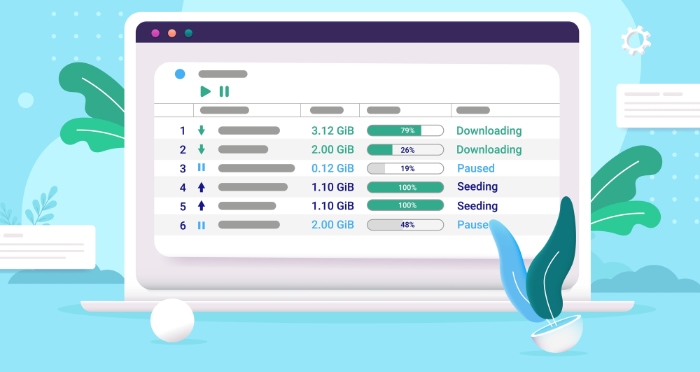Understanding Seeds, Leeches, and Other Torrenting Terms

Torrenting has revolutionized the way we share and access files online. Whether you're downloading a software update or grabbing the latest episode of a popular TV series, the chances are that you've encountered the world of torrents.
But how well do you know the lingo that surrounds this file-sharing ecosystem? Terminology like “seeds,” “leeches,” “peers,” and “trackers” often populate the discussions and forums dedicated to torrenting. A solid grasp of these terms not only elevates your understanding but also optimizes your experience when using torrents.
What are Seeds?
Seeds are a critical element in the torrenting ecosystem that can dramatically influence the speed and efficiency of your downloads. Let's explore what seeds are, their importance, and how they contribute to the overall health of a torrent.
Definition of Seeds
In torrent terminology, a seed is essentially a peer that has downloaded the entire file and is now sharing it with others. When you download a torrent and continue to share the downloaded content, you become a seed for that particular torrent.
The Role of Seeds in Download Speed
One of the most immediate impacts of seeds is on the download speed. Torrenting operates on a Peer-to-Peer (P2P) network.
The more seeds a torrent has, the more sources are available for a faster download. It's a basic principle of supply and demand: more suppliers (seeds) usually result in quicker service (download speed).
Why More Seeds are Beneficial
A higher number of seeds not only increases the download speed but also improves the reliability of the download. With multiple seeds, the chances of getting the entire file increase exponentially.
Additionally, having more seeds reduces the load on individual seeders, making the process more efficient for everyone involved.
Transitioning from a Peer to a Seed
After successfully downloading a file via a torrent, you automatically become a seed, as long as you keep the torrent file active in your client. Your computer then contributes to other users looking to download the same file, as you now possess the complete file that can be shared.
This transition helps maintain a healthy balance between seeds and leeches, ensuring the longevity of the torrent.
Through seeds, the torrent community benefits from accelerated download speeds and enhanced reliability. They are an integral component that fosters a robust and efficient torrenting environment.
The Role of Leeches
While seeds are often celebrated for their positive impact on torrenting, leeches are generally viewed less favorably. However, understanding the role of leeches can offer a more nuanced view of how torrenting works.
What are Leeches in Torrenting?
A leech is a user who downloads files from a torrent but does not offer the complete file for upload in return. Unlike seeds, leeches do not contribute to the health of a torrent in a positive way, as they take more than they give back to the network.
Impact on Torrent Health
Leeches can significantly slow down the download speed for others because they consume resources without replenishing them. When the number of leeches outweighs the number of seeds, the torrent becomes less efficient.
In extreme cases, this imbalance can lead to a torrent dying out, as there are not enough seeds to maintain it.
Partial vs. Full Leeches
Not all leeches are created equal. Partial leeches share some parts of the file while downloading others.
In contrast, full leeches download the entire file without sharing any part of it. While partial leeches still contribute somewhat to the network, full leeches are generally considered detrimental.
The Transition from Leeches to Seeds
Leeches don't always remain as such. When a leech downloads the complete file and starts sharing it, they transition to becoming a seed.
However, the faster this transition happens, the healthier the torrent remains. The presence of too many leeches who take a longer time to become seeds can put the torrent at risk of becoming inefficient or dying out altogether.
Understanding Peers

The term ‘peer' often appears in discussions about torrenting, but what exactly does it mean? A peer is essentially any computer participating in the download or upload of a torrent file.
Definition of Peers in the Torrent Network
In the context of torrenting, a peer is any computer that is connected to the torrent swarm, either downloading or uploading a particular file. When you use a torrent client to download or upload files, your computer becomes one of the many peers in that torrent's network.
The Dynamic Role of Peers
Peers have a dynamic role. They can function as seeds or leeches depending on their stage in the download or upload process.
A peer that has downloaded a complete file and is sharing it becomes a seed. Conversely, a peer that is still downloading a file is considered a leech.
Importance of Peers
Peers are the building blocks of the torrent network. They constitute the user base that ensures files can be shared and downloaded.
The efficiency of any torrent depends on its active peer count. More peers generally mean a healthier torrent, but the ratio of seeds to leeches among those peers is also a critical factor.
Interrelationship Between Peers, Seeds, and Leeches
It's essential to see peers as a broader category that includes both seeds and leeches. All seeds and leeches are peers, but not all peers are seeds or leeches.
The role of a peer can change over time, evolving from a leech to a seed or vice versa, based on their actions and the state of the file they are sharing or downloading.
Peers serve as the foundational units of any torrenting activity. They can adapt roles, becoming either seeds or leeches based on their level of participation in the file-sharing process.
The vitality and efficiency of a torrent largely depend on the number and type of peers involved, making them a critical element in the torrent network.
The Significance of Trackers
Trackers play a behind-the-scenes but vital role in the functioning of torrents. These specialized servers facilitate the communication among all participants in the torrent network—whether they are seeds, leeches, or peers still in the process of downloading or uploading.
What is a Tracker in Torrenting?
A tracker is a server that keeps track of which seeds and peers are in the swarm for a specific torrent. When you use a torrent client to download or upload a file, the client communicates with a tracker to find other peers.
In essence, the tracker helps in initiating and maintaining connections between different peers.
How Trackers Operate
Trackers do not host the content being downloaded; they simply act as middlemen that facilitate connections between peers. When a torrent client wants to download or upload parts of a file, it queries the tracker, which then provides a list of peers to connect with. The actual file sharing occurs directly between peers.
Types of Trackers: Public vs. Private
Trackers can be categorized as public or private. Public trackers are open to anyone and are the most common type. However, they can be less secure and offer files that are of inconsistent quality. Private trackers, on the other hand, are invitation-only and often host higher-quality files. They also tend to be more secure but can be challenging to join.
Role in Torrent Health
Trackers are crucial for maintaining the health of a torrent. They ensure an effective peer-to-peer network by continuously updating the list of peers, thereby enabling more efficient file sharing.
This, in turn, supports both the longevity and the speed of the torrent, as long as there is a balanced number of seeds and leeches.
Trackers serve as the operational backbone of the torrenting process, directing traffic and ensuring that file sharing occurs as smoothly as possible. Whether public or private, their role is to maintain an organized and efficient system where files can be shared quickly and reliably.
Demystifying Magnet Links
Magnet links have become increasingly prevalent as a way to share and download torrent files. Unlike traditional torrent files, magnet links offer a more convenient and faster method to initiate downloads.
What Are Magnet Links?
A magnet link is a hyperlink containing a torrent's hash code, which is a unique identifier for that specific file. Clicking on a magnet link automatically opens your torrent client and begins the downloading process without requiring you to download a separate torrent file first.
How Magnet Links Work
When you click on a magnet link, it prompts your torrent client to search for peers that are sharing the file associated with the link's hash code. Unlike traditional torrent files, magnet links do not need to be downloaded and then opened.
Instead, they facilitate a direct search for the file within the torrent network, making the process quicker and more straightforward.
Advantages of Using Magnet Links
Magnet links offer several benefits over traditional torrent files. They are less susceptible to file corruption and cannot be easily blocked by ISPs or administrators.
Furthermore, they streamline the downloading process by eliminating the need to download an additional file to initiate the download.
Security Implications
While magnet links offer convenience, they are not without their risks. Because magnet links make it easier to share files, they can also be used to spread malicious software.
Therefore, it's essential to exercise caution and only use magnet links from reputable sources.
Magnet links represent a significant evolution in the way torrent files are shared and downloaded. By offering a more efficient, secure, and convenient method, they have become a favored option for many users in the torrenting community.
Their rise in popularity underlines the constant innovations taking place in the torrenting world, making file sharing more user-friendly and efficient.
Conclusion
Torrenting is more than just downloading or uploading files; it's a complex system where multiple elements come together to form a functional network. From seeds that serve as the pillars of a healthy torrent to leeches that can either slow down or contribute to the process, each element has its role and impact.
Trackers act as the facilitators, keeping the system organized, while magnet links offer a newer, more efficient way to share files. Understanding these terms and their functions can significantly enhance one's torrenting experience, making it more efficient and secure.


